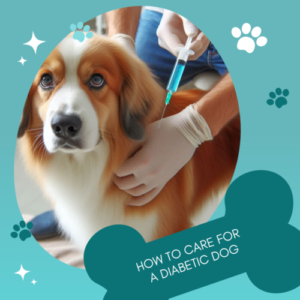
How to Care for a Diabetic Dog: Nurturing Health
One thing Toddy and I (Julie) have learned is that caring for a dog with diabetes requires dedication, understanding, and a commitment to their well-being. We definitely had to adjust our lives a bit to keep our diabetic miniature poodle, Brady, happy and healthy. But we have discovered that with the right approach and proper management, dogs with diabetes can enjoy a high quality of life and continue to be a source of love and joy in your family. This article delves into key strategies for effectively caring for your furry friend diagnosed with diabetes.
Establish a Consistent Routine:
Consistency is the most important thing when caring for a dog with diabetes. Create a daily routine that includes regular feeding times, insulin administration, exercise sessions, and blood sugar monitoring. Brady eats the same meal, twice a day, every day at the same time. I feed him in the mornings because I am the morning person in our family. He eats between 6 and 6:30 am. Then we take a walk. On weekdays, it’s just 10-15min around our little neighborhood. He has his favorite places to visit and do his business. On the weekends we do some longer walks. Toddy feeds him dinner at 5:30-6 pm because Brady has been more active during the day and acts hungry at that time. We learned to pay attention to his hunger based on the blood sugar curves we collect (more on this in the next paragraph). After dinner, we take another 10-15min walk around the neighborhood. Dogs thrive on predictability. The key is having a structured routine that helps stabilize their blood sugar levels and overall health.
Monitor Blood Sugar Levels:
Regular monitoring of your dog’s blood sugar level is essential for keeping their diabetes in check. Work closely with your veterinarian to learn how to use a blood glucose monitor and record readings. Early in our journey with Brady, I’ll be honest, this was a frustrating and difficult thing for us to learn. However, Toddy and I were living in Kyiv, Ukraine at the time, and I had promised Brady I would keep him out of the hospital. We had to learn to do the curve ourselves, or be willing to have the vet keep him all day and do the testing for me. At the beginning, it took some time to find the right insulin dosage so we were testing him at least once per week. Tracking the trends in his blood sugar levels and sending them to the vet allowed us to work as a team to fine tune insulin doses, diet, and exercise until we found the routine that worked for Brady to maintain stable sugar levels and prevent complications. It is worth the frustration I felt while I was learning. I feel confident testing Brady now . I am empowered to catch problems early. The next post explains the tips I have for making this process go smoothly. You can feel confident too.
Maintain a Balanced Diet:
Diet plays a significant role in diabetes management. Consult your vet to develop a suitable meal plan that aligns with your dog’s specific needs. Opt for high-quality, low-carbohydrate dog food that supports stable blood sugar levels. Toddy and I feed Brady with the prescription food recommended by our vet. (Fun fact: in Kyiv, and also in Bangkok you can just buy this food off the shelf like any other food. Not so in the US where you have to buy it from your vet or have a prescription.) We use: a combination of dry and wet food that we mix with a couple tablespoons of boiled, chopped, boneless, skinless chicken; a teaspoon of flax seed; Milk Thistle (silymarin); a probiotic supplement: and glucosamine. Brady is 12 years old and has some old age aches and pains at times, so we have added glucosamine in the last year. We combine wet, and dry, and add chicken because, at first, he did not like his new diet. We played around with different things until we found something he eats enthusiastically. Feeding your dog a consistent diet is crucial to managing their health and happiness. (There will be a discussion about treats in a later post.)
Stay Vigilant and Seek Professional Guidance:
Constant vigilance is necessary to detect any changes in your dog’s behavior or health. Be alert to signs of hypo- (low) or hyper- (high) glycemia (blood sugar). These signs may include weakness or disorientation when blood sugar is low. When the blood sugar is high the symptoms include excessive thirst and urination. High levels also make their urine sticky because it is full of sugar. Changes in appetite are always something to pay attention to. We’ve become students of Brady. We can tell by the way he trots out to go to the bathroom how he is feeling that day. As good neighbors, we always collect his poop. It seems a bit gross, but just noticing the consistency and odor (or better, lack of odor) of the stool as we pick it up in the baggy tells us a lot about Brady’s digestive health. When we notice any unusual symptoms that concern us, we consult our veterinarian immediately. Better safe than sorry. I’d rather ask a “silly” question, than miss something I should have noticed. I truly believe that regular check-ups and ongoing communication with your vet are vital for monitoring progress, making necessary adjustments to the treatment plan, and avoiding emergencies.

Conclusion:
Caring for a dog with diabetes requires patience, education, and unwavering dedication, but it can be done. Once you establish a consistent routine, it gets easier. I promise, you will feel comfortable monitoring blood sugar levels, maintaining a balanced diet, administering insulin, and seeking professional guidance when you need it. Brady is happy and full of energy these days. He trots around our neighborhood with a bounce in his step. He loves to play games and chase after his squeaky toys. His appetite is good and his health is excellent according to our most recent vet visit. Remember that with your commitment, you and your dog can lead a happy and fulfilling life despite their diabetes diagnosis.
Thanks for reading. We would love to hear about your experiences. Please share any comments, questions or suggestions in the comments below You can also email me directly at julie@carefordiabeticdog.com. We are here to help.


Thanks for this informative article on caring for diabetic dogs. Toddy and Julie’s dedication is admirable. I’m curious: How did you successfully establish a consistent feeding routine, considering different schedules? Could you share more insights on adjusting insulin doses based on blood sugar trends? Also, how do you balance Brady’s activity level on weekends versus weekdays? Thanks for sharing your experience; it’s truly valuable for fellow pet owners like myself.
Thanks Liam. I’m so glad you found the information useful. Thank you for your good questions.
The routine has come to take precedence over most other considerations when we make our plans. We try to do things in time to get home before his evening meal, or wait to go out until after he is fed. When we can’t do that, we usually get someone to keep him for the night, or have a neighbor we trust come in and feed him and give him his shot. In a real pinch, we will feed him as much as an hour different in either direction, but we really try not to do that.
The short answer on insulin is that once you’re in a routine where you are feeding, and exercising in consistent amounts, the dose of insulin should remain the same. That is one advantage to managing diabetes in dogs versus humans. Same food, same exercise, same dose.
On the weekends, I usually take him for a 30 minute walk in the mornings. When we get back I give him some low sugar treats to compensate for the extra exercise.
All very good to know. Thanks for sharing your valuable knowledge.